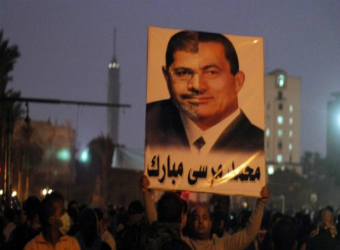Democracy Index put the number of protests held against President Mohamed Morsi’s regime during its first year at 9427. The Cairo-based Index released on Monday its first annual report about the number of protests held during President Morsi’s term so far, precisely since 1 July 2012 until 20 June 2013.
The Index works under the International Development Centre (IDC). The report cited a 700 percent increase in the number of protests during the past year when compared to former President Hosni Mubarak’s last year in power, as the average of protests per month rose from 176 protests in 2010 to 1140 protests in 2013.
Mohamed Adel, IDC executive director, stated that several taboos were destroyed after the 25 January revolution in 2011; taboos that stood as a roadblock in the way of potential protests. “Most of the fears citizens had nurtured before the revolution are gone now,” Adel said. “Also, before the revolution, citizens usually failed to recognise most of their rights, a fact which has now changed.” Adel nevertheless stated that this factor does not strongly contribute to the big rise in protests during the past year. He said that the destruction of taboos started during Mubarak’s final year in power.
The report stated that the percentage of protests increased by 100 percent during the second half of Morsi’s first year in power when compared to protests during the first half of the year. The index cited 60 sectors which participated in the protests. Labour protesters ranked highest among those sectors, forming 49 percent of the protests; precisely 4609 protests. Coming next were the general public protests, where ordinary citizens took part in 27 percent of the protests. Political activists and civilians ranked third, contributing to the 9427 protests by 13 percent.
Protests were mainly triggered by socio-economic demands, the Index reported, which instigated 67 percent of the protests. Protests calling for the release of detainees and justice for the victims of the revolution made up 31 percent of the total protests.
The Index stated that the regime’s “continuous attempts to control all state institutions, exclude all opposition movements and crackdown on freedoms rights” were all instigators to such protests. The Index broke down the different forms of protest to include: 2387 demonstrations (25.3 percent), 1013 strikes, 811 sit-ins, 503 marches, 482 rallies and 80 human chains, 1555 road-blockages, 248 hunger strikes, 28 attacks on officials’ convoys, 18 physical attacks of institutions and 16 cases of torching institutions. The report stated that the nationwide protests monitored during the past year reflected a shift of de-centralisation.
It said that although the majority of protests took place in the capital (1570), it stood at only 16.7 percent of the protests, a smaller percentage when compared to previous years. Gharbeya (684 protests) ranked second, Sharqeya (624 protests) ranked third and Alexandria (624 protests) ranked fourth. Marsa Matrouh hosted the lowest percentage of protests nationwide. The report expected that the 30 June planned protests would be violent.
It stated that “the anger caused by the regime which is currently taking over large sectors of citizens would provide a convenient atmosphere for violence”. It called on those organising the protests to structure a mechanism which would minimise the level of possible violence and chaos. “No solutions would be available to the current crisis until the regime is ousted,” Adel said.
He added that the state’s conditions during the past year did not only remain at a standstill, but they actually deteriorated. The presidency launched an official website about Morsi’s first year in power on Thursday. The website included official statistics of protests, putting the number of protests held during the past year at 5821. Statistics also referred to 7709 demonstrations and 24 planned million-man marches all held during the last year.
Source: Egypt Daily News


